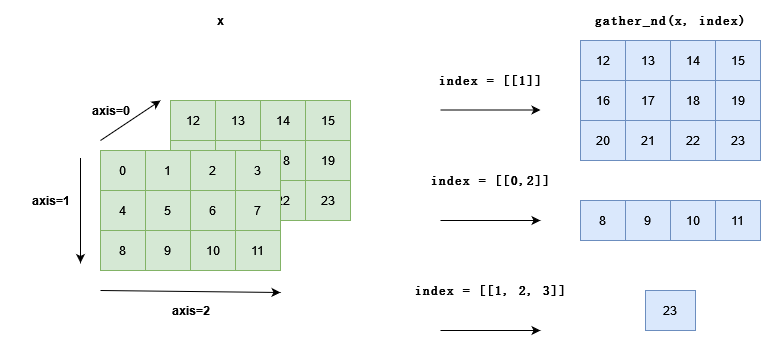gather_nd
gather 的高维推广,并且支持多轴同时索引。index 是一个 K 维度的 Tensor,它可以认为是从 x 中取 K-1 维 Tensor,每一个元素是一个切片:
\[output[(i_0, ..., i_{K-2})] = x[index[(i_0, ..., i_{K-2})]]\]
显然,index.shape[-1] <= x.rank 并且输出 Tensor 的维度是 index.shape[:-1] + x.shape[index.shape[-1]:] 。
示例:
给定:
x = [[[ 0, 1, 2, 3],
[ 4, 5, 6, 7],
[ 8, 9, 10, 11]],
[[12, 13, 14, 15],
[16, 17, 18, 19],
[20, 21, 22, 23]]]
x.shape = (2, 3, 4)
- 案例 1:
index = [[1]]
gather_nd(x, index)
= [x[1, :, :]]
= [[12, 13, 14, 15],
[16, 17, 18, 19],
[20, 21, 22, 23]]
- 案例 2:
index = [[0,2]]
gather_nd(x, index)
= [x[0, 2, :]]
= [8, 9, 10, 11]
- 案例 3:
index = [[1, 2, 3]]
gather_nd(x, index)
= [x[1, 2, 3]]
= [23]
示例图解说明:
参数
x (Tensor) - 输入 Tensor,数据类型可以是 int32、int64、float16、float32、float64、bool。
index (Tensor) - 输入的索引 Tensor,其数据类型 int32 或者 int64。它的维度
index.rank必须大于 1,并且index.shape[-1] <= x.rank。name (str,可选) - 具体用法请参见 api_guide_Name,一般无需设置,默认值为 None。
返回
shape 为 index.shape[:-1] + x.shape[index.shape[-1]:]的 Tensor,数据类型与 x 一致。
代码示例
>>> import paddle
>>> x = paddle.to_tensor([[[1, 2], [3, 4], [5, 6]],
... [[7, 8], [9, 10], [11, 12]]])
>>> index = paddle.to_tensor([[0, 1]])
>>> output = paddle.gather_nd(x, index)
>>> print(output)
Tensor(shape=[1, 2], dtype=int64, place=Place(cpu), stop_gradient=True,
[[3, 4]])
